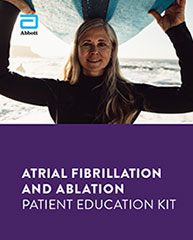Atrial fibrillation (AFib) is the most common type of heart arrhythmia.1 It affects 38 million people worldwide,2 and that number is expected to double by 2050.3
Patient education has been shown to improve treatment adherence, satisfaction and clinical outcomes.4 As AFib cases continue to rise, healthcare professionals can improve patient management with increased education.

AFib Patient Education Website
Share www.AFAnswers.com with your patients. It features patient-focused content about AFib and its treatment options, like cardiac ablation.

References
- Chugh SS, Haymoeller R, NarayananK et al. Worldwide epidemiology of atrial fibrillation: a Global Burden of Disease 2010 study. Circ. 2014; 129:837-847.
- Lippi G, Sanchis-Gomar F, Cervellin G. Global epidemiology of atrial fibrillation: An increasing epidemic and public health challenge. Int J Stroke. 2021 Feb;16(2):217-221. doi: 10.1177/1747493019897870. Epub 2020 Jan 19. Erratum in: Int J Stroke. 2020 Jan 28;:1747493020905964. PMID: 31955707.
- Go A, Hylek E, Phillips K, Chang Y, et al. Prevalence of Diagnosed Atrial Fibrillation in Adults: National implications for rhythm management and stroke prevention: the AnTicoagulation and Risk Factors In Atrial Fibrillation (ATRIA) Study. JAMA. 2001; 285(18): 2370-5. https://jamanetwork.com/journals/jama/fullarticle/193807
- Timmers, T., Janssen, L., Kool, R.B., and Kremer, J.A.M. (2020). Educating Patients by Providing Timely Information Using Smartphone and Tablet Apps: Systematic Review. Journal of Medical Internet Research, 22(4). https://doi.org/10.2196/17342
MAT-2116121 v2.0

